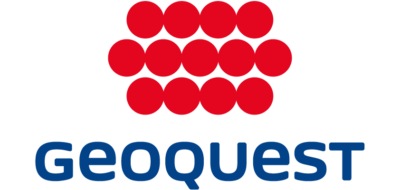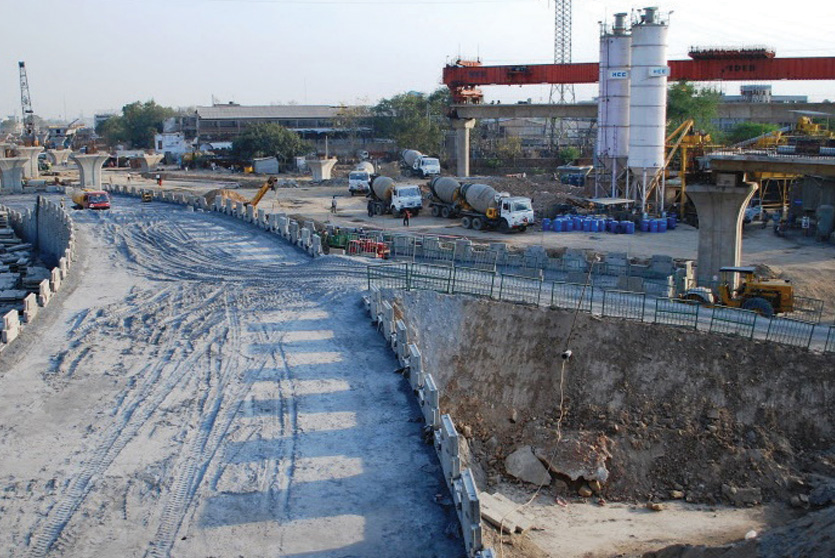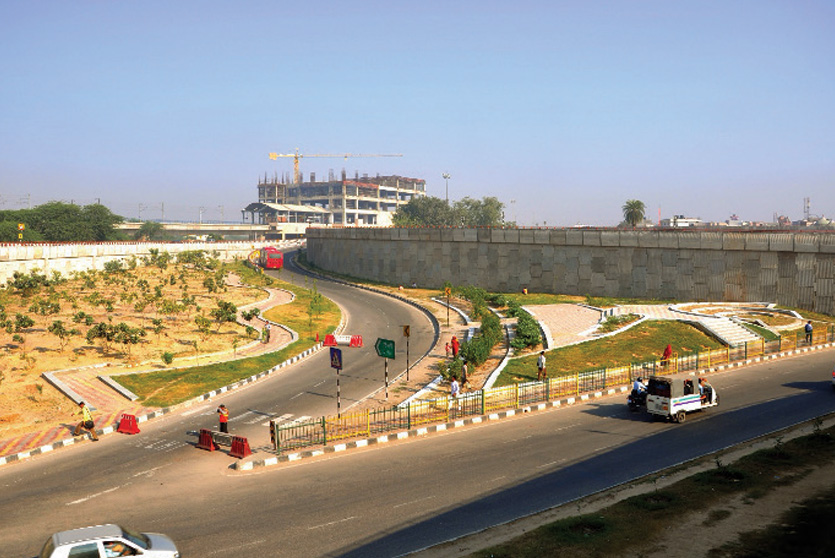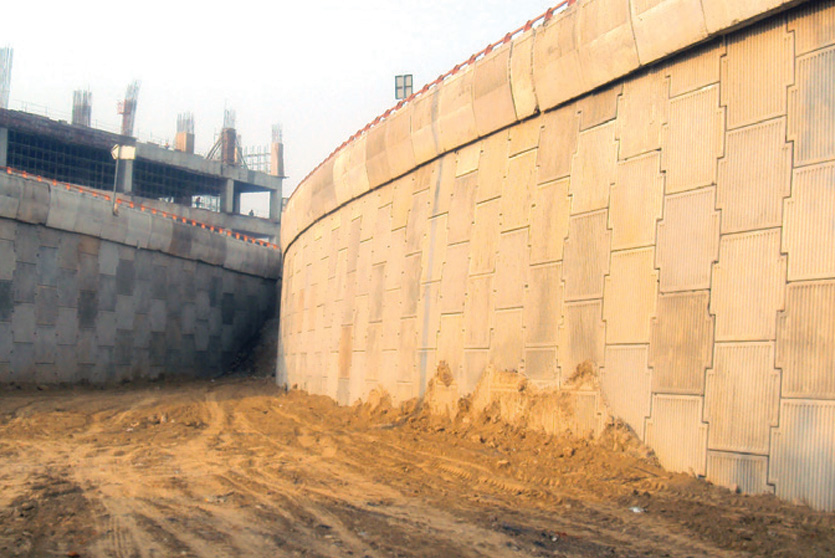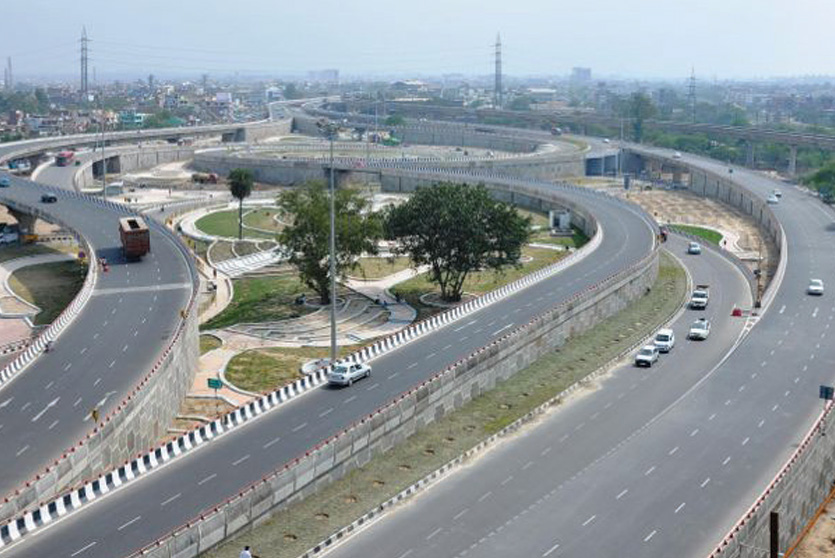Reinforced Earth® wall at Delhi – Faridabad Skyway
Project Details
OWNER
National Highways Authority of India (NHAI)
DESIGNER
Geoquest India (Formerly known as Reinforced Earth India Pvt. Ltd.)
DESIGN CONSULTANT
Tandon Consultant Pvt Ltd.
CONTRACTOR
Hindustan Construction Company Ltd.
CONSTRUCTION
May 2009 – September 2010

Background
The Delhi- Faridabad Skyway project was conceived to ease the traffic congestion at the Badarpur junction on Delhi – Mathura Road, National Highway No. 2 (presently National Highway No. 19), which is the virtual border between the states of Delhi and Haryana. This 4.4 km elevated highway is the gateway to the National Capital, New Delhi, from central and eastern India. The six-lane skyway originates at National Thermal Power Corporation, power plant at Badarpur, New Delhi and terminates at Sarai Chowk, Sector-37 of Faridabad, Haryana with an amazing cloverleaf interchange at Badarpur intersection. This project is fully elevated with several up and down ramps without any traffic signals for free-flowing movement of vehicles. The project was undertaken by concessionaire “Badarpur Faridabad Tollway Limited”, a subsidiary of Hindustan Construction Company Limited (HCC).
The project was initially designed with complete viaduct structure. It was not the most optimized design. HCC redesigned the flyovers and decided to use retaining wall in several locations to replace viaduct structure. There were many complex arrangements in the retaining walls such as multi-tier retaining walls, converging walls, sharp bends in the wall etc. HCC, therefore, decided to chose Geoquest as the technology partner in the project for their engineering excellence, knowledge on the Reinforced Earth technology and experience in handling complex projects.

Challenge
- This project is located at a key urban junction at the border of national capital having heavy traffic movement. Maintaining safety and convenience of commuters during construction was a critical part of this project.
- Due to heavy traffic congestions, intra-site and inter-site movement of the machineries and materials were taking longer time than usual and it was challenging to meet the construction milestones.
- Fly ash was used in this project as reinforced and retained backfill material. Managing the air pollution potentially caused by the lighter particles of fly ash and subsequent health hazard to the commuters and densely populated locality in this area was a significant challenge.

Solution
Fly ash (Bottom Ash) from the nearby thermal power plant was used as the reinforced and retained backfill material for the Reinforced Earth® structure in this project. In the detailed design process, Geoquest India proposed a system compatible with the corrosive property of fly ash. Geoquest India designed the structures with ArmaGrid Strip (Polester) (G-strips) coated with Polyvinyl Chloride (PVC) as soil reinforcing elements with their patented HDPE loop connectors with insulated galvanized steel toggles. The structural part of the system did not consist of any steel component exposed to fly ash backfill so that any potential damage due to corrosive nature of the backfill is avoided. Although the fly ash had an angle of internal friction(Ф) ≥ 32°, the design of the structures was done considering a lower Ф value of 28o.
Geoquest India used their engineering know-how, global and local technical expertise to meet the requirements of the client and design the Reinforced Earth® structures in the most holistic way. Adequate resources like shutter moulds, manpower, machineries etc. were mobilized to the site by Geoquest India keeping their commitment towards a tight construction schedule in mind.
The construction of 40,000 sq Reinforced Earth® wall was completed in the stipulated time without any cause for complaint or safety lapse.
Special Features and Advantages
- The Peak Ground Acceleration in the project location is 0.24g. Reinforced Earth® is resilient to high seismic load due to its flexible characteristics.
- Compatibility of the system with fly ash contributed towards Government of India’s vision of using fly ash in infrastructure projects.
- Reinforced Earth® can adapt very well under differential settlement without any structural damage.
- This is an urban infrastructure project located in a highly populated area with limited availability of land and Reinforced Earth® Wall proved to be very efficient in terms of its constructability.
- Reinforced Earth® technique enabled the on-time completion of the project under challenging environment.
- Reinforced Earth® structure are economical when compared to other available soil retaining structures viaduct; and the client could save money by using this technique in this project.
Project Specifications
Structure
Reinforced Earth® Walls
System
TerraClass® with ArmaGrid Strips and HDPE
loop connection
Panel Type
TerraClass® (1.5m x 1.5m x 0.18m)
Area
40,000m²
Maximum Height
9.73m
Design Live Load
24kN/m3
Design Life
100 years
Soil Reinforcement
PET (Polyethylene Terephthalate) ArmaGrid
(G-strips) coated with Polyvinyl Chloride
Reinforced and Retained fill:
Pulverized Fuel Ash (Fly Ash) from Thermal
Power Plant
